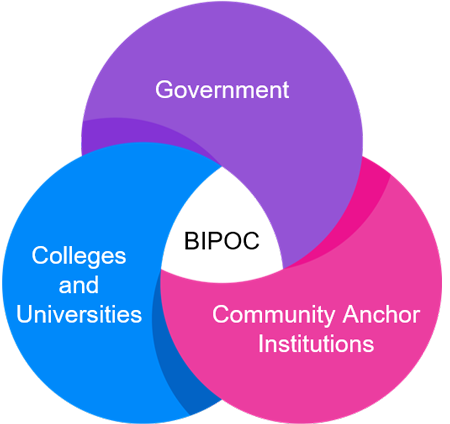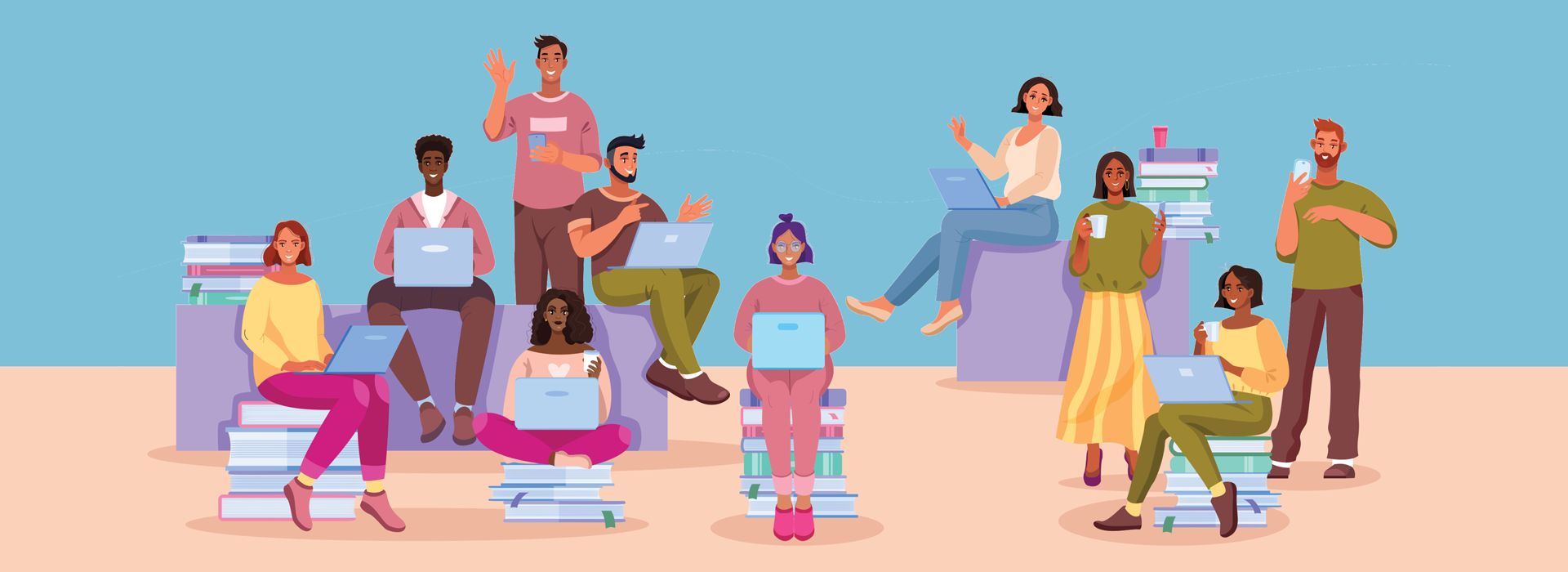Does the growth of online technologies lead to an increase or a decline in the equity of the availability of high quality post-secondary education to all? The suddenness of the move online resulting from the pandemic was a special case with obvious and important inequities. What about the long term? In this article I will address the question of educational equity for black, indigenous and people of color (BIPOC) students, in an increasingly online world. This article expresses some of my thoughts and findings.

My colleagues and I found interesting research in the topic of technology access and equity in online learning. We also had the opportunity of interviewing professionals in the matter of equity, diversity, inclusion and belonging with extensive experience within the context of higher education. One of them is Dr. Yolanda Medina, Professor, Chairperson in the area of Teacher Education at Borough of Manhattan Community College (BMCC), who also has a Ph.D. in Cultural Studies in Education. I also interviewed Ms. Molree Williams-Lendor, JD, LMSW, former Executive Director for Equity and Title IX Coordinator at Barnard College, and current Director of Workplace Culture and Inclusion at NYU Langone Health.
Other sources of information are the colleges and universities where the interviewed professionals and panelists work, as well as my alma mater. NYU has the Office of Equity, Belonging, and Community Action, which is part of Steinhardt School of Culture, Education, and Human Development. Barnard College has a Council for Diversity and Inclusion, which mission is “to rigorously educate and empower women, providing them with the ability to think, discern, and move effectively in the world—a world that is different from when the College was founded.” Borough of Manhattan Community College (BMCC) has the Office of Compliance & Diversity, focusing on policy enforcement, compliance and addressing formal complaints of unlawful discrimination or harassment.
Equity and Equality in Higher Education
Molree Williams-Lendor,
Director, Workplace Culture and Inclusion
“Online learning is very important for equity, if you have the right tools and the right environment to support it, which can be a complicating factor as well.”
What is equity in higher education? Equity in higher education refers to conditions that ensure that all students receive what they need to be successful through the intentional design of the college experience. Equity does not mean equality, although both concepts are related. While the two terms seem nearly identical, equity and equality have vastly different meanings. Equality in higher education means that every student gets the same resources and opportunities. Examples of equality in higher education are when institutions receive the same funding, or institutions that have open admission policies, where all students who meet the basic education requirements are admitted. In instructional design, we ensure equality by granting equal access to all the instructional materials that we create. Equality is important and essential, but it is not sufficient for students of socially disadvantaged backgrounds to succeed when pursuing higher education.
Equity in higher education, not only allows equal access to all students, but also provides the means for equal participation and support to achieve success in their higher education experience, considering their particular situation. Equity is crucial in every classroom of every higher education institution to ensure that all students obtain the same positive outcomes regardless of where they started or what unique challenges they might experience. In instructional design, in addition to provide equal access to learning, we also provide the means for engagement, representation, and action and expression when creating and implementing instructional materials. That implies that our designs can adapt to matching multiple ways in which students can be engaged or motivated to learn. In online education, equity also provides the technological means for all students to have the same learning experience, that is, access and support to all students’ technological needs.
Online Education and Non-traditional Students - Before the COVID-19 Pandemic
Online education has proven to be an effective means to broaden access to instruction by serving students who otherwise would not be able to matriculate in traditional programs. Many BIPOC students fall into that category of “non-traditional students”. However, non-traditional students also include other types of students, such as older students who are attending school while employed, students who are located some distance from campus, disabled students, active military students, and students in urban settings with high commuting costs.
Dr. Yolanda Medina,
Professor, Chairperson, Borough of Manhattan Community College
“Community colleges did not receive any funding from the state. I haven’t even inquired about the rationale for that.”
Though many higher education institutions have developed online courses to meet the needs of traditional and non-traditional students, online education requires specific access to specific technologies, and also requires technology knowledge to navigate and use online campuses.
According to the experts, many BIPOC students also fall into the non-traditional student category due to being working parents and lack of support from their families. It’s important to emphasize that lack of support is not always due to hostility towards the students’ goals of pursuing higher education. Many times BIPOC students are also first-generation college students, and their families don’t have the know-how on how to provide appropriate support to the student. However, in some instances due to cultural and/or religious beliefs, family members do not provide support to some BIPOC students. Here is what the experts have to say:
Existing Inequities - After the COVID-19 Pandemic
In order to achieve equity in higher education, first we need to take a look at where the inequities happen. What are the barriers that cause disparities in higher education, and who is the most affected by such barriers? Also, are there factors that impact higher education students specifically, and if so, what are such factors?
In 2020, due to the COVID-19 pandemic, all educational institutions, including higher education, forced all students to transition into online learning. This situation has given researchers and professionals in the matter of the digital divide and higher education an opportunity to place the topic of technology access to higher education students right at the center stage. Researchers conducted studies that focus on the impact that the emergency transition into online learning had in the effectiveness of access and use of technology for education, revealing inequities in access to both the technology and additional support services from colleges and universities. Universities and colleges had to address the prevalence of inadequate technology among college students.
One study found that approximately 16%-19% of college students reported technology barriers, that is, inadequate computer hardware or Internet connection, that inhibited participation or adequate participation in online learning. When comparing lower income students with higher income students, there were much higher rates of such technology inadequacies. In low-income students it was 20%-30%, whereas in high income students it was 10%-12%. However, now more than ever, colleges and universities possess the necessary infrastructure to teach online. In addition, universities house more diverse students than any previous generation of college students.
Although the issue of lack of adequate technology access for online learning was prevalent during the highest peak of the pandemic, other issues around online learning are worth mentioning. Some studies also identified several barriers that are related to online learning, but not related to technology access. The emergency transition to online learning had many institutions and professors unprepared to deliver traditional classroom instruction within a medium that some never had used before. These impacted all students, not just BIPOC students.
“Systemic barriers, such as the declining purchasing power of Pell Grants, inequitable resources across colleges, and job market discrimination, make it more difficult for BIPOC students and students from low income backgrounds to not only complete their degree, but also receive the same returns on those degrees as their White and higher-income peers.”
- The Institute for College Access & Success
According to research, among a number of students who were surveyed on the most common obstacles for online learning that they experienced during the COVID-19 pandemic, the mentioned the obstacles listed below (in order of percentage who placed that obstacle as the most important):
- Lack of motivation for online learning (76%)
- Lack of interaction/communication with other students (64%)
- Inability to learn effectively in an online format (61%)
- Distracting home environment or lack of access to an appropriate study space (56%)
- Course content that is not appropriate for online learning (43%)
- Lack of clear expectations for online learning from instructor(s) (39%)
- Lack of access to your instructor(s) (28%)
- Lack of access to academic advising (19%)
- Inability to attend classes at their scheduled online meeting time (18%)
- Inability to access learning support services (16%)
- Lack of access to technology necessary for online learning (16%)
- Lack of familiarity with technical tools necessary for online learning (14%)
Motivation for online learning was the most commonly mentioned obstacle in the survey. This information suggests the need for good instructional design and delivery of online instruction; mere availability of the required technologies does not address any of these issues. It’s worth noting that obstacle number five directly relates to instructional design. For BIPOC students, these factors add to the disadvantages that they experience. Dr. Medina talks about addressing these issues, along with the issues of technology access for students at BMCC. She also sheds light on a much less discussed issue, which is, BIPOC students who lost loved ones to the pandemic:
Access to and Adoption of Technology
Mobile devices provide flexible access to education that can help to reach students in remote locations, especially those in underserved communities, who face many restrictions in obtaining a basic education. The use of mobile technology to access and interact with electronic learning materials benefit students’ academic performance (Ally, Balaji, Abdelbaki and Cheng, 2018). Equity in access, however, cannot be accomplished without the cooperation and coordination of the major players, which are the government, higher education institutions and community anchor organizations.
Federal and State Approaches

Before the pandemic, federal and state government agencies have made efforts in closing the socioeconomic digital divide. The Broadband Technology Opportunities Program (BTOP) is a grant program administered by National Telecommunications and Information Administration (NTIA) to help bridge the technological divide; create jobs; and improve education, health care, and public safety in communities across the country. BTOP projects are deploying broadband Internet infrastructure, enhancing and expanding public computer centers, and encouraging the sustainable adoption of broadband service. New York State is participating in a national program to map the availability of broadband, or high-speed Internet service. As part of this program, the NYS Office of Information Technology Services is tasked with gathering data about broadband services at Community Anchor Institutions.
During the pandemic, states leveraged recent legislation or passed new legislation to help bridge the digital divide, particularly in terms of broadband access. They streamlined bureaucratic and regulatory models, supported community and private sector engagement and training, leveraged state resources, and made other financial investments in broadband access. The federal government implemented the CARES Act, that allocated a 14-billion-dollar higher education emergency relief fund to provide cash grants to college students for costs such as course materials, technology, food, housing, and child care. New York State was awarded over $14 billion in federal education COVID response funding through the Coronavirus Aid, Relief, and Economic Security (CARES) Act. However, community colleges did not receive any of that money; only 4-year colleges received funding. Here are the thoughts of Dr. Medina on the topic of government funding:
Community Anchor Institutions
Community Anchor Institutions (CAIs) are places where citizens who lack broadband at home can make use of the Internet or where a broadband connection is critical to the services they provide. Examples of Community Anchor Institutions include Libraries, Schools and Colleges, Hospitals, Municipal Halls, Police Stations and Fire Stations. Anchor institutions are essential to providing broadband access to unserved and underserved populations unable to maintain computer service in individual homes because of financial or technological impediments. New York State is participating in a national program to map the availability of broadband, or high-speed Internet service. The program is part of a national effort administered by the NTIA. As part of this program, the NYS Office of Cyber Security (OCS) is tasked with gathering data about broadband services at Community Anchor Institutions.
Colleges and Unniversities
In order to support students with adequate technology during the emergency transition, several universities used several approaches. BMCC lent iPads to students during the pandemic, though there were still many challenges in the use of mobile devices with Blackboard. Barnard, on the other hand, already has an office named Access Barnard, that leverages resources to support students who identify as international, first-generation, or low-income, to bridge the gaps that first-time undergraduates often face. That existing support infrastructure played a key role in access to technology and resources to minority students. Ms. Williams-Lendor didn’t work at Barnard when the pandemic hit, but Dr. Medina talks about lending equipment to students
So, to answer the question...
Does the growth of online technologies lead to an increase or a decline in the equity of the availability of high quality post-secondary education to all? Research and experts agree that it leads to an increase in the equity of the availability of post-secondary education. However, there might be a decrease in the high quality education that requires instructor modeling and the provision of additional support services.
References
- Ally, Balaji, Abdelbaki and Cheng (2018). Use of Tablet Computers to Improve Access to Education in a Remote Location. Journal of Learning and Development. Vol. 4, No. 2, pp. 221-228
- ‘A national crisis’: As coronavirus forces many schools online this fall, millions of disconnected students are being left behind. Washington Post. August 16, 2020.
- Data for Equity: Closing Racial and Economic Gaps Through a Federal-State Partnership. The Institute for College Access & Success. https://ticas.org/
- Jaggars, S. S., Motz, B. A., Rivera, M. D., Heckler, A., Quick, J.D., Hance, E. A., & Karwischa, C. (2021). The Digital Divide Among College Students: Lessons Learned From the COVID-19 Emergency Transition. Midwestern Higher Education Compact.
- Meyer, A., Rose, D.H., & Gordon, D. (2014). Universal Design for Learning: Theory and Practice. Wakefield, MA: CAST Professional Publishing.
- NYCLU releases full data, topline results from statewide remote learning, internet access survey. New York Civil Liberties Union. May 2021.
- Rose, D. H., & Meyer, A. (2002). Teaching every student in the digital age: Universal Design for Learning.
- The Digital Divide: Researching the Challenges of Online Learning for Many Students. The New York Times. March 27, 2020.

